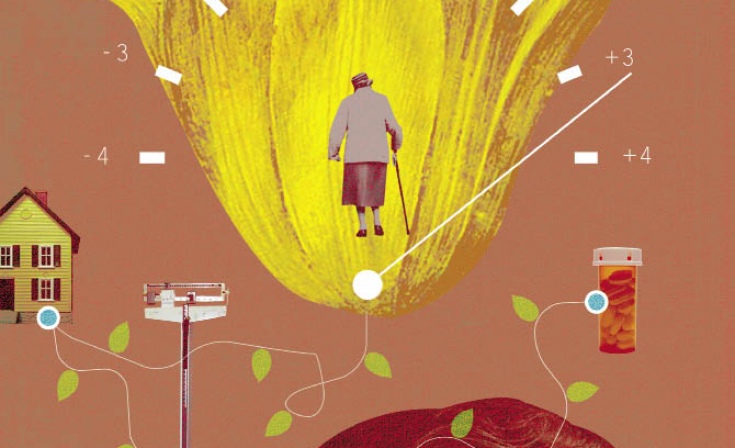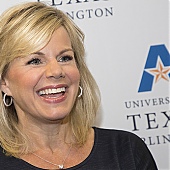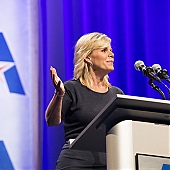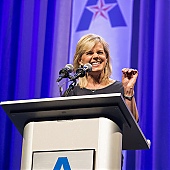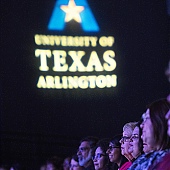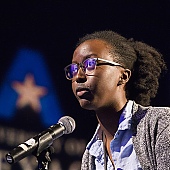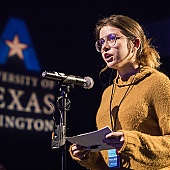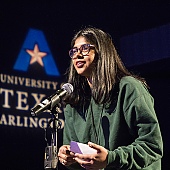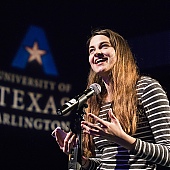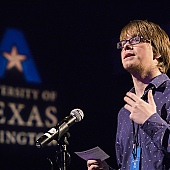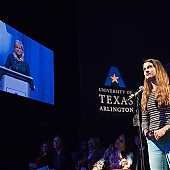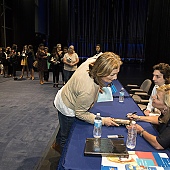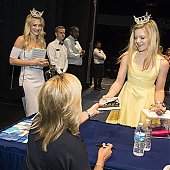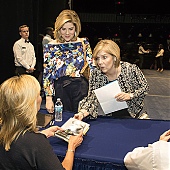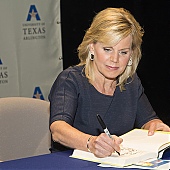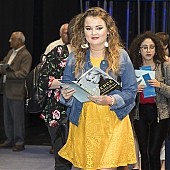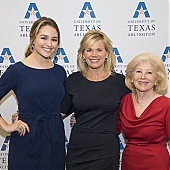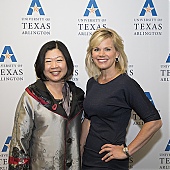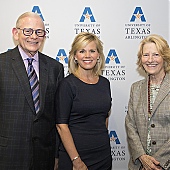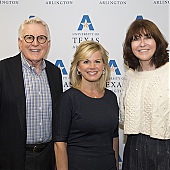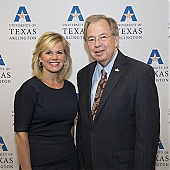Linked to Longevity
By 2030 Americans 65 or older will represent nearly 20 percent of the country’s population. Novel UT Arlington initiatives exploring exercise, memory, high-tech homes, and caregiving are helping this growing demographic lead healthier, fuller lives.
· Spring 2011 · Comment ·
By 9 a.m. weekdays, the Maverick Activities Center buzzes with students coming and going. Studying in lounge areas and working at computers, they’re a serious lot, focused on the day at hand.
The mood is markedly lighter back in the new Center for Healthy Living and Longevity, where 20 people older than 65, some of them strapped into weight vests, walk laps around the gym. An instructor calls them to rows of folding chairs, where they stand, sit, stretch, and lift their arms, performing chair exercises until it’s time to walk again. In the next room, another group plays Wii games on a balance board and competes on a bowling computer game.
“If we can get you to the gym and change the physiology of the brain, then you can remember to go to the dry cleaners.”
The smiles after any success are brilliant. These people have lived long enough to know it’s a good idea to enjoy the moment. The goal of the study: to determine if exercises and games can help prevent falls.
Across campus in various disciplines, UT Arlington researchers and instructors are studying ways to help the nation’s growing elderly population enjoy more moments. Wisdom comes with age, but so can ailments, forgetfulness, and isolation.
More than one in eight Americans is older than 65. The 40 million people in that age group are expected to increase to 55 million in 2020.
High-tech UT Arlington discoveries may one day give caregivers ways to monitor whether someone has gotten up, taken medication, eaten, moved around, or fallen. Other studies and programs explore memory and exercise.
SOUND MIND AND BODY
Lucille Oltion, a blonde in a new pair of New Balance sneakers, perches on a folding chair at the Maverick Activities Center (MAC) and talks about her routine: two-mile run-walks three times a week, regular visits to Curves fitness centers, and three trips a week for hour-long sessions at the MAC.
Oltion is 90. Like 50 percent of women over 75 nationwide, she lives alone. Her husband, with whom she loved to go gambling, died two years ago. “I like to be fit,” the Arlington resident says, “and I like to be with people.”
That makes her perfect for kinesiology Assistant Professor Chris Ray’s trial. The Kinesiology Department is leading efforts by the newly formed Center for Healthy Living and Longevity.
Balancing Act
Offered through the Center for Healthy Living and Longevity, a study headed by kinesiologist Chris Ray, right, aims to keep Charles Clay and others 65 and older from falling.
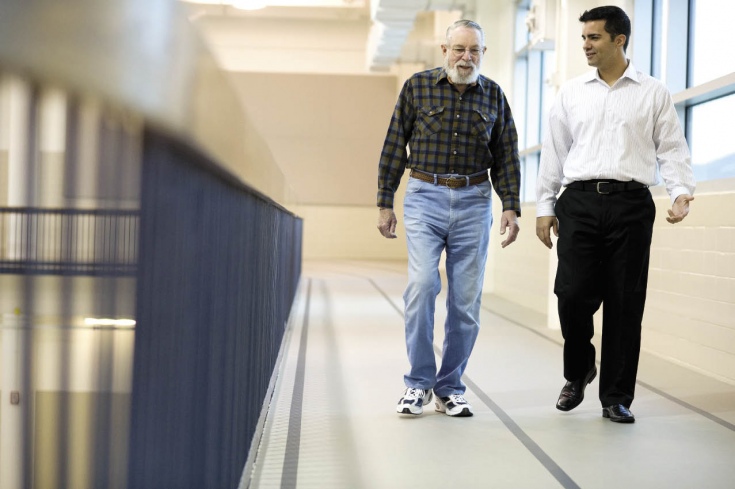
In this study, Dr. Ray seeks ways to prevent falls. His project involves evaluating the subjects’ balance, as well as assessing their ability to use sensory information like vision. Because many falls take place when seniors are multitasking, that also is evaluated. The subjects are tested initially, during, and after the 15-week intervention.
Improvements are occurring in overall fitness—some weight loss and gains in walking distances—and in popularity of the trial. “Our numbers are exploding,” Ray says. He and his colleagues started with 35 subjects found through word-of-mouth referral. Now he has 90 participants, with another 70 on the waiting list.
What drives the participation? Ray says fear can be a great motivator. Says Oltion: “I had a bad fall. I stayed in the bed a lot. I didn’t know a fall could do that to you.”
Juanita Ornelas, 74, of Mansfield says she and her husband signed up because they “want to stay as healthy as possible so we won’t be a burden to our kids.” They already walked an hour and a half a day at the mall but wanted more.
The trial gives participants a bone density test, which was an eye-opener for Ornelas. “They gave me information about how much risk I had of breaking a bone. That gave me an incentive to start taking calcium.”
“When I exercise, it makes me feel better,” Oltion adds. “I know it’s certainly better than sitting home playing games on the computer.”
Psychology Assistant Professor Timothy Odegard also has older people working out at the MAC, but for different reasons. Anyone who has ever forgotten why she walked from the bedroom to the kitchen will hope for success in this study on the effect of cardiovascular fitness on memory.
Dr. Odegard’s 12 subjects, 65–75 years old, first stay idle for three months and get baseline brain scans. Then they do cardio on a treadmill for another three months and repeat the scans. The idea is to gauge whether cardio reactivates regions of the brain that may have slowed or stopped functioning.
The interdisciplinary study includes psychology Ph.D. student and project leader Crystal Cooper, kinesiology faculty members Judy Wilson and Brad Heddins, and researchers from UT Southwestern Medical Center at Dallas and UT Dallas.
While it seems obvious with the push to exercise at any age, Odegard says that to his knowledge no one has ever scientifically studied the impact of cardiovascular exercise on memory. The bottom line, he says, could be a greater incentive to stay active.
“If we can get you to the gym and change the physiology of the brain, then you can remember to go to the dry cleaners.”
TECHNOLOGY TO THE RESCUE
Across campus, research at the Heracleia Human-Centered Computing Laboratory is leading to ways to monitor whether someone remembered to take medication or eat. Researchers in the project directed by Fillia Makedon, chair of the Computer Science and Engineering Department, aren’t using live subjects, but they’re looking at real situations, including falls and caregiver concerns.
Housed in the new Engineering Research Building, the lab is named after a city in antiquity where Hellenic culture thrived.
“It’s important for computer scientists’ work to have personal appeal.”
“We chose this name to symbolize an imaginative world where technologies are at the service of humans, with a focus on those who need special help, thus bringing out the human side of technology,” says Dr. Makedon, who organizes the international conference, Pervasive Technologies Related to Assistive Environments—in short, using technology to help the elderly or disabled.
The work could enable a son, daughter, physician, or other caregiver to monitor from afar whether an elderly person got out of bed, took medication, remained active through the day, watched TV, ate, went to bed, and slept restfully.
Sensors at a mock apartment at Heracleia transmit radio frequencies that can be monitored. They go on a bed (as pressure pads), at thresholds, on the TV, refrigerator, in a “smart drawer” where medication is stored. Users could deactivate the system if, for example, a group of people visited.
Remote Control
Sensors at a mock apartment in the Heracleia Human-Centered Computing Lab could enable caregivers to monitor the daily activities of an elderly person.
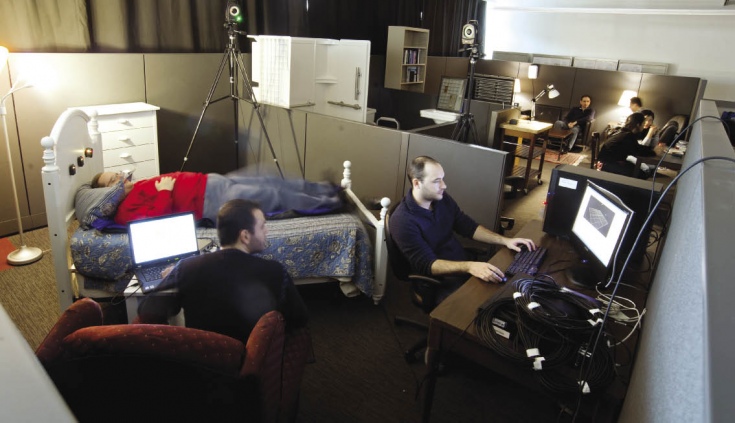
Eric Becker, who works with fall detection as well as other aspects of the research, says a robot might be programmed to monitor an elderly person for a fall and alert caregivers using Skype. Robots also could detect emotions based on facial expressions and determine whether a senior adult is depressed.
About 31 percent of the elderly population, or 11.2 million people, live alone, so monitoring will become more important as the number swells.
Privacy is a key issue in this research—ensuring the data is secure and deciding who should see it. Another focus is keeping the equipment affordable and accessible. Makedon’s team also is compiling a library of inexpensive computer games that Alzheimer’s patients or people with disabilities can play at home to help with memory and other functions.
“It’s important for computer scientists’ work to have personal appeal,” she says.
PREPARED TO CARE
As we continue to live longer, the number of really elderly—those 85 and older—is growing. Americans in that age group should number roughly 5.7 million this year and grow by 15 percent to 6.6 million in 2020, according to the federal Administration on Aging. And with greater age, we often need more care.
That’s where Kathryn Daniel’s department steps in. Dr. Daniel directs the Adult and Gerontological Nurse Practitioner program in the College of Nursing.
She says the demand for more gerontological care is increasing primarily because of the increasing numbers of older Americans, but also because some older Americans may wait until their Medicare kicks in before consulting a doctor. The prevalence and incidence of many chronic diseases increase with age. Daniel’s graduates (baccalaureate-prepared registered nurses with a master’s degree in advanced practice) help fill the need by caring for such patients in primary and specialty care practices, nursing homes, hospices, patients’ homes, and hospitals.
They are proficient in fields that specifically affect the elderly: managing chronic disease, preventive care, screening, and counseling. Nurse practitioners can help guide care for an elderly patient as they transition through the many sites where health care is delivered today.
Daniel is also the program manager for Smart Care, a discovery and demonstration center for technologies to help senior citizens, people with disabilities, and injured veterans live healthier and longer in their own homes. Using a $634,500 grant from the U.S. Health Resources and Services Administration, researchers work with business and industry partners to integrate advanced sensors, wireless communication, and other technologies into a simulated home environment.
If Ray, Odegard, Makedon, Daniel, and others at UT Arlington have their way, more older patients will lead healthier lives, with less fear.
Meanwhile, back at the Maverick Activities Center, the studies continue.
Raul Ramirez, research coordinator for Ray’s project, looks impatient. Oltion and Ornelas already have missed a computer session and are about to miss laps in the gym. Oltion has begun talking proudly about her late husband’s skill at the baccarat table.
Ramirez has everyone moving, gives weight vests to those who may need additional strength training, and generally keeps an eye on the program. As she heads back to the gym, it’s obvious that Oltion’s dedication to exercise and her bright, active mind at 90 are a testament to the possibilities.
“Walking helps me,” she says. “Walking—and praying, some days.”
Web extra: Watch a video.

